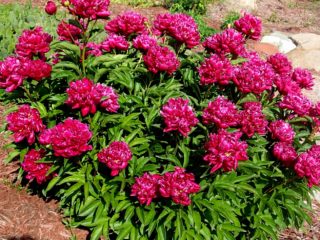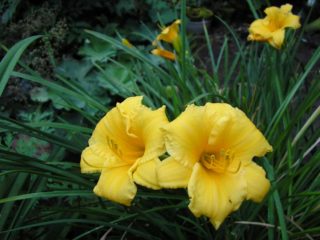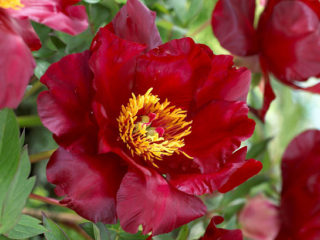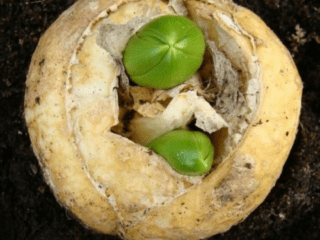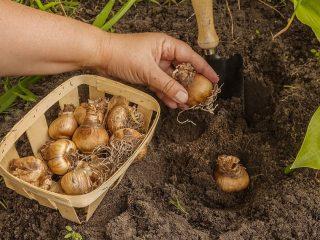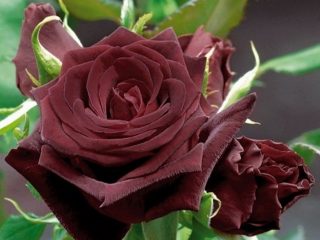Content
Varieties of garden perennial geranium with photos and descriptions need to be studied before planting the crop on the site. The plant comes in a wide variety; you can choose between miniature and tall species.
What does garden geranium look like?
Geranium, or crane bird (Geranium) is a plant of the Geranium family, represented by hundreds of species. It has palmate or lobed leaves on petioles; in some varieties the plates are covered with light pubescence.
In May or early June, garden geraniums bloom with five-petalled buds of blue, pink, white or purple with small veins. The decorative period takes at least 40 days; in good conditions, the crop can bloom much longer. The fruits of the plant are capsules that, after ripening, open from bottom to top.
Geranium is distributed throughout the world, is unpretentious, and grows in tropical and temperate climates.It does not make any special demands on the soil; it can grow on almost any soil, as long as it is not waterlogged. However, most varieties do not tolerate winter cold well - high frost resistance is the exception rather than the rule.
Types and varieties of garden geranium with photos and names
Garden geraniums come in tall and dwarf varieties, with large and miniature buds. Before planting a perennial on your site, you should familiarize yourself with the most popular varieties.
Balkan
Tall Balkan geranium (Geranium macrorrhizum) reaches 1.5 m above the ground. It has a strong massive root and lobed long-petioled leaves. The buds of the plant are light pink or deep red. Flowering of the garden variety begins in May in the south or in June in temperate climates. In its natural form, geranium is widespread in the Alps, the Carpathian Mountains and the Balkans. Often settles on dry soils and rocky areas.
In a garden at the dacha, you can place the crop both in bright sun and in the shade. But in the latter case, the plant will bloom less profusely. When growing the variety, it is necessary to avoid waterlogging of the soil.

Balkan geranium flowers reach 3 cm in diameter
Wallich
Wallichian geranium (Geranium wallichianum) is a perennial up to 30 cm tall. Found in nature in Northern India and Afghanistan, it spreads widely to the sides up to 1.2 m. It has long leaves up to 15 cm. It bears saucer-shaped buds of a dark purple or lilac hue with a light core and dark veins.
Due to its ability to grow widely in diameter, Wallich's cranebird is often planted in vacant lots. It is recommended to combine the variety with garden irises or gladioli, which will effectively frame the crop.
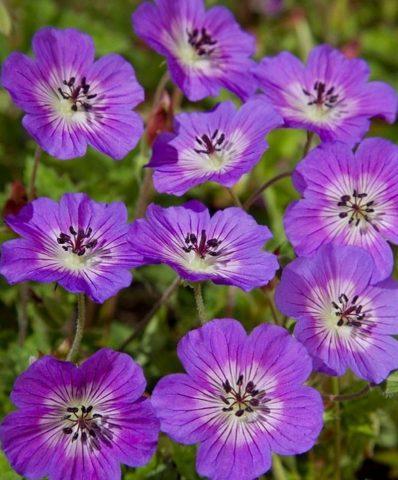
Wallich's geranium blooms from mid-summer and remains decorative until October
Gorgeous
Magnificent geranium (Geranium magnificum) is a hybrid variety obtained by crossing flat-petaled and Georgian species. It blooms in July with bright blue buds; the leaves of the plant are strongly dissected, hairy, with jagged edges. It reaches a height of 50 cm, suitable for single and group planting. Photos of pelargonium garden flowers show that the culture prefers well-lit areas and develops much worse in the shade.
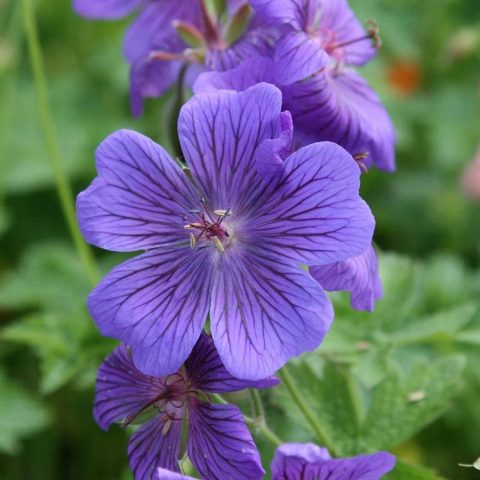
Magnificent garden geranium tolerates cold snaps down to -20 ° C if provided with shelter.
Himalayan
Himalayan geranium (Geranium himalayense) is a plant that blooms throughout the summer with bluish-purple buds with dark red veins. It has large rounded lobed leaves. The flowers are quite large, up to 5 cm in diameter, arranged in small shields. During the decorative period, the crop emits a light, pleasant aroma.
The variety prefers well-drained and loose soils and grows well in sunny areas and light shade. It reacts poorly to waterlogged soil with excess humus content.
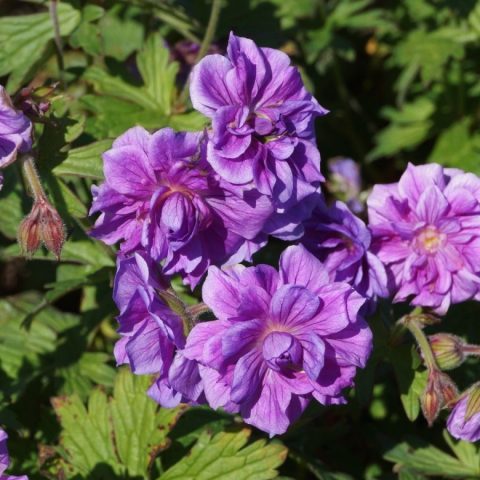
The height of Himalayan geranium is about 60 cm
Georgian
Georgian geranium (Geranium ibericum) is a tall variety up to 80 cm above the ground. The leaves of the variety are round, with jagged edges and light bluish pubescence. At the beginning of autumn they gradually acquire a red tint. Flowering occurs in mid-summer and lasts up to one and a half months; geranium buds are purple with red veins, large and bright.
The plant does not have any special requirements for care.It can be planted in a moderately lit area; watering is carried out up to three times a week in hot weather. During the period of active growth, it is allowed to add fertilizers to the soil, but in general the crop develops well even without fertilizing.

The lifespan of Georgian geranium varieties is about ten years.
Dalmatian
Miniature Dalmatian geranium (Geranium dalmaticum) reaches only 15 cm above ground level. At the same time, the bushes can spread up to 50 cm in width. The buds of the crop are pink, up to 3.5 cm in diameter. The leaves are green in spring and summer, but turn reddish in the fall and die back before winter sets in. The plates are beautiful, heavily cut along the edges. In its natural form, the plant can be found in Albania and Montenegro; the variety is cultivated artificially mainly in the southern regions.
Dalmatian cranebird grows well in alkaline, well-drained soils. It is recommended to plant the variety in illuminated areas. The plant does not like swampiness and dense shade. The garden variety is used to decorate rock gardens and is also used in borders.
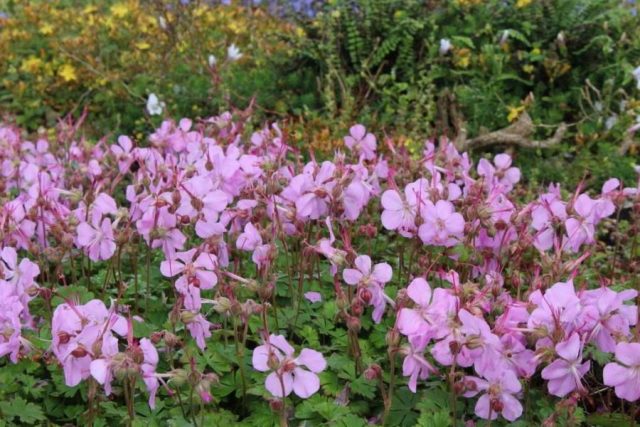
Dalmatian geranium is drought-resistant and takes root well in rocky gardens.
Cantabrian or Cantabrigenian
The hybrid Cantabrigien variety of geranium (Geranium cantabrigiense) was bred on the basis of the Dalmatian and large-rhizome species. Flowering occurs from early to late summer, with small purple, pink or white buds appearing on the shoots. The leaves of the garden perennial are shiny green, up to 9 cm in length. They emit a characteristic pleasant aroma.
Cantabrian geranium is frost-resistant and develops well in the middle zone. It is better to plant it on drained and fertile soils without stagnant moisture.
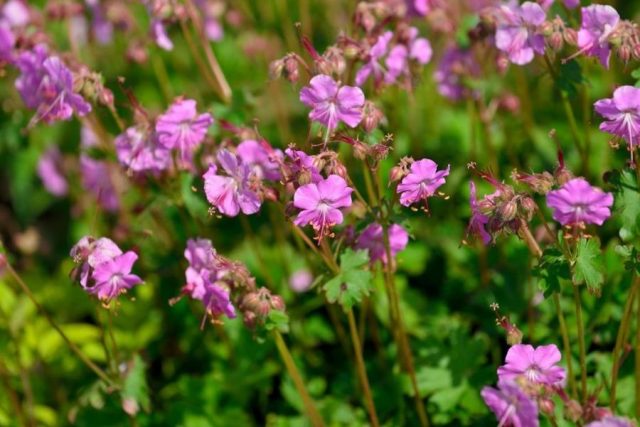
Cantabrian geranium reaches only 30 cm above the ground surface
Red-brown
Red-brown geranium (Geranium phaeum) is a perennial garden variety suitable for growing in shaded areas. It has straight branched shoots, the plates are emerald green, sometimes with a purple pattern in the center. The photo of a variety of garden geranium with dark leaves shows that the flowers of the plant are purple with a white spot in the middle. The petals spread up to 2.5 cm in diameter.
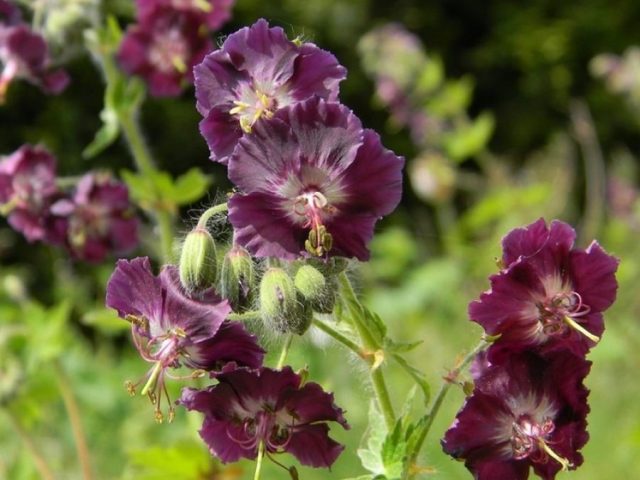
The height of red-brown geranium is about 70 cm
Blood red
Blood-red cranebird (Geranium sanguineum) is a garden perennial plant up to 50 cm above the ground. It has rigid branched stems and leaves on long petioles. The blades are bright green in summer, but turn red in autumn. The buds of the variety are burgundy and light pink, reaching 4 cm in width.
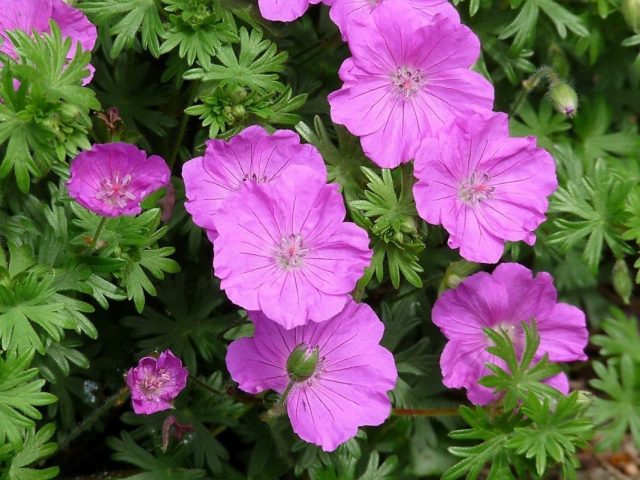
Blood red geranium blooms in June and July
Large rhizomatous
Large-rhizome cranebird (Geranium macrorrhizum) is a variety that is found naturally only in the subalpine zone of the Balkans. It is distinguished by a long and branched rhizome that spreads along the surface of the ground. Leaf blades extend from the rosette on petioles up to 20 cm long.
Flowering of the large-rhizome crane grass begins in June and lasts about a month. The buds of the variety are reddish or purple, up to 3 cm in diameter. At the end of July and August, the seeds of the plant ripen. One of the best varieties of garden geranium emits a pleasant aroma.

The height of large rhizomatous geranium is only about 10 cm
Lesnaya
Forest cranebird (Geranium sylvaticum) is a garden variety up to 80 cm with a vertical or slightly inclined root in the ground with a thickening in the upper part.The stems of the plant are straight, branched at the ends, the leaves form a rosette. The flowers are large, pink-lilac or bluish in color.
The woodland crane is common in Eurasia in temperate and cold climates. In Russia it is found in Siberia, in the middle zone and in the Caucasus. Settles in moist, fertile soils, often growing in shady deciduous forests and bushes.
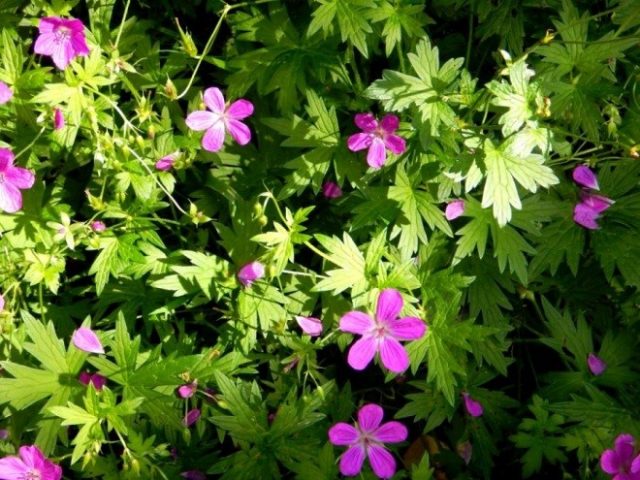
Forest geranium blooms in June and July
Lugovaya
Meadow cranebird (Geranium pratense) is a perennial plant with a thick rhizome and single straight stems. The leaves of the variety are long near the base, and shorter in the middle part of the shoot. The flowers reach 1.7 cm in diameter; the ovoid petals can have a bluish, violet or lilac color.

Meadow geranium grows up to 80 cm above the ground
Small-stamen
Small-stamened geranium, or Armenian geranium (Geranium psilostemon) is a garden variety that is naturally found in the highlands in birch groves and bushes. The root of the crop is thick and short, the leaves are five-parted on petioles up to 30 cm. The plates appear at the end of April, and in the fall they turn red and gradually die off. The height of the small-stamened cranebird reaches 70 cm.
In mid-June, the garden plant blooms with bright crimson buds with a black eye. The decorative period lasts about 45 days; the fruits ripen in July and August.
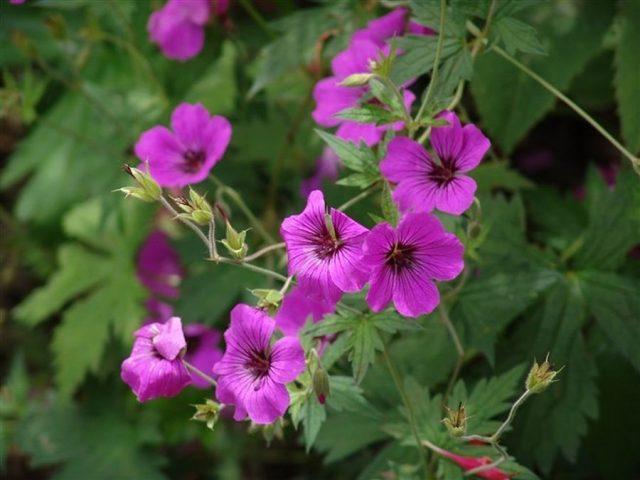
Small-stamen geranium can bloom in one place for up to 15 years
Flat petal
Flat-petalled cranebird (Geranium platypetalum) is a Caucasian garden variety that has been popular since the 19th century.It forms tall, dense bushes up to 70 cm above the ground, spreading up to 100 cm in diameter. The leaves of the variety are bluish-green, densely pubescent, up to 12 cm wide. In June, blue-violet buds up to 5 cm in diameter with wide petals notched at the edges appear on thin straight stems. The decorative period of the garden variety lasts about two months.
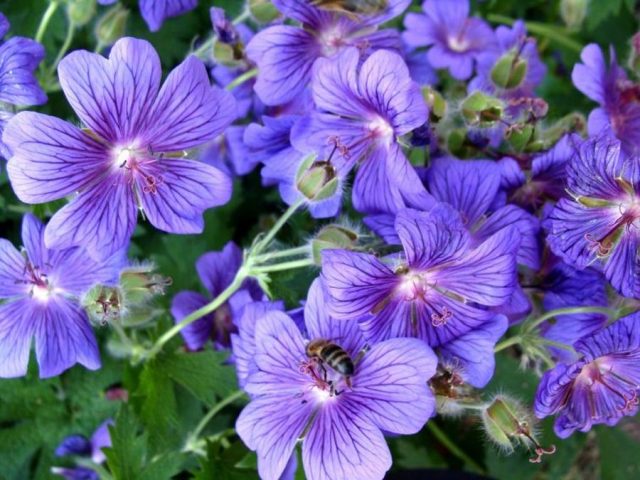
Flat-petaled geranium prefers to grow in sunny, fertile areas
Oxford
Oxford cranebird (Geranium oxonianum) is a hybrid plant that blooms from July to late August. It is a creeping variety and can grow in shaded areas. Flower growers use the plant as a ground cover. A variety of garden terry perennial geranium produces bright pink buds. It reaches a maximum height of 50 cm.
The Oxford cranebird spreads very quickly throughout the area and can fill empty space. At the same time, the plant must be regularly shaped, otherwise it will turn into a weed.
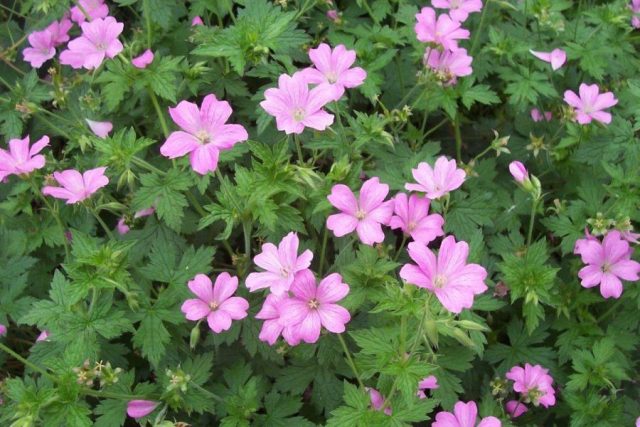
Oxford geranium tolerates cold temperatures down to -39 ° C
Renard
Renard's geranium (Geranium renardii) is a compact garden variety. It has olive-green leaves with a grayish coating. From July to August it blooms with lavender buds with purple veins, collected in umbrella-shaped shields. It is drought-resistant and prefers the most illuminated areas in the garden.
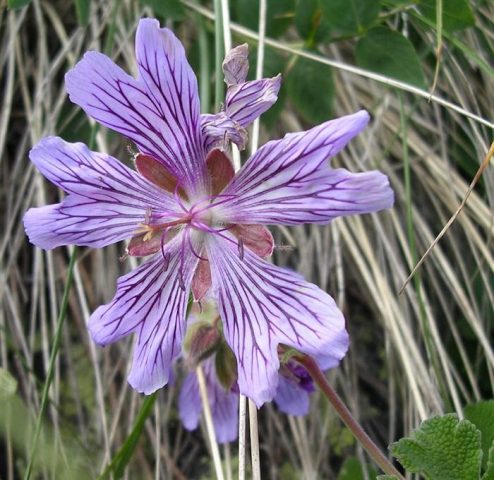
Renard's geranium rises up to 30 cm above the ground
Roberta
Robert's geranium (Geranium robertianum) is an annual variety found wild in Europe, Central Asia and the Caucasus. It has a thin root and diamond-shaped, five-part leaves. The stem of the plant is straight and branched. The flowers are small, pale pink, with rounded petals. During the decorative period, the crane bird emits a sharp and spicy aroma.
The variety continues to flower throughout June and July; the seeds ripen by August. If you do not cut the buds on time, the grains will spill out onto the ground, and Robert's geranium will begin to multiply by self-sowing. The garden annual is distinguished by its grace and endurance and does not require special care. The decorative quality of the crop is provided not only by the buds, but also by the leaves, which acquire an orange-red hue with the onset of autumn.
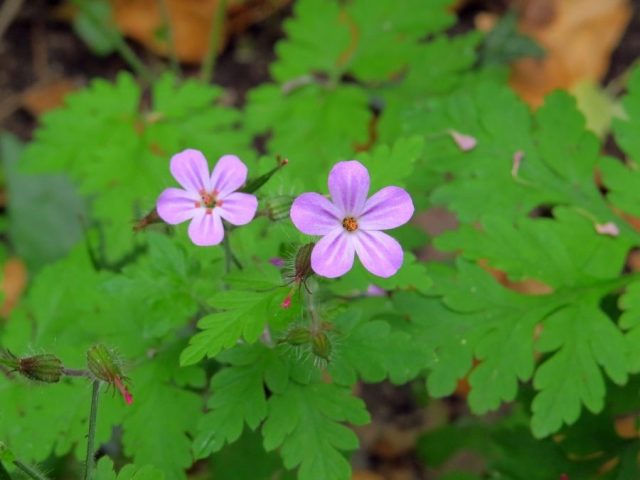
Robert's geranium rises up to 30 cm above the soil surface
Roseanne
The garden geranium variety Rozanne (Geranium Rozanne) blooms from July to September. Bears large blue cup-shaped buds with a white core. It emits a pleasant aroma and is used in the design of borders and rockeries. Also suitable for cutting and for creating floral arrangements. The height of the garden perennial reaches a maximum of 50 cm. The stems of the crane tree are branched and strong.
In its natural form, the Rosanna variety is widespread in Russia, Africa, the USA and China. Tolerates the central climate well and is not afraid of short droughts. It is better to plant a garden variety on neutral or slightly acidic soil containing peat. Geranium needs sun, but can grow in light partial shade.
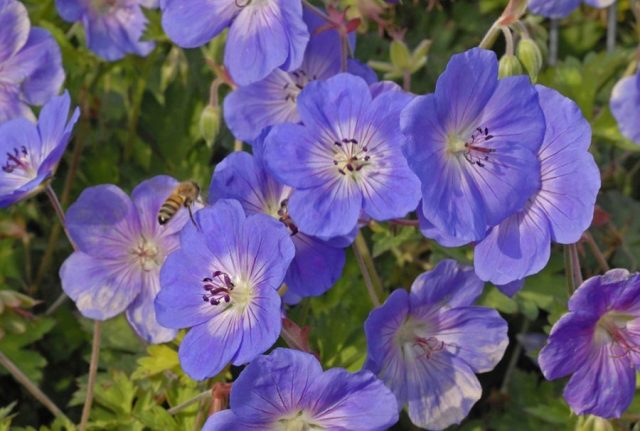
The height of geranium Rosanna is 40 cm
Gray or ashy
Blue geranium (Geranium cinereum) is a perennial variety common in Southeast Asia, the Caucasus and southern regions of Europe. It is characterized by its small growth, reaching only about 15 cm above the ground surface. The leaves of the plant are five- or seven-lobed, round, up to 6 cm in diameter, and have a gray-green tint.
In July and August, ash geranium blooms profusely with pink-purple buds, collected in inflorescences of two. The variety bears fruit in August and September.

Ash geranium has been in cultivation since the mid-19th century
Endressa
Endress geranium (Geranium endressii) is a garden perennial up to 50 cm above soil level. It blooms for a long time from May to mid-summer; the buds are bright pink, up to 4 cm wide. The decorative effect of the plant is emphasized by large lobed leaves with jagged edges. Perennial garden geranium is frost-resistant and can develop in the middle zone.
In its natural form, the variety is distributed in the Western Pyrenees. Prefers poor soils; it grows worse on fertile soil. Grows in both sun and partial shade. It tolerates pruning well, so it is often used as a garden crop.
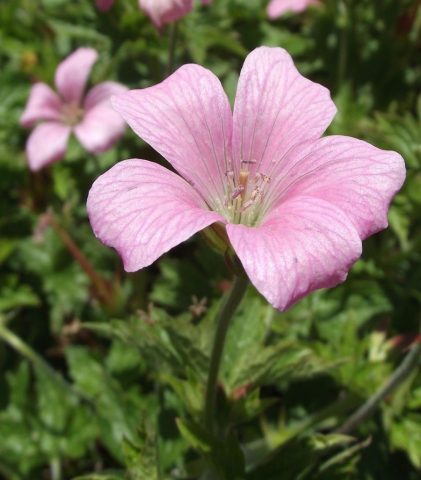
Endressa geranium can be planted in the trunk circle of tall shrubs and trees
Conclusion
Varieties of garden perennial geraniums with photos and descriptions allow you to get an idea of the diversity of crop types. For a summer cottage, you can choose a flower of any shade and height - the crane bird can be both compact and quite tall.
